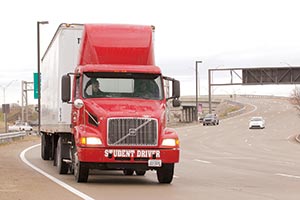Senior Reporter
Industry: Training Proposal to Worsen Driver Shortage

This story appears in the April 18 print edition of Transport Topics.
Many in the trucking industry say the Federal Motor Carrier Safety Administration’s proposed entry-level driver training rule has the potential to exacerbate the nation’s driver shortage. The rule requires that students log at least 30 hours of behind-the-wheel training time.
About 300 comments were filed with the agency earlier this month. While they varied widely, many trucking stakeholders echoed those made by the West Virginia Trucking Association.
“The arbitrary requirement centered on hours distracts from a greater importance of performance and competency,” the association wrote April 6. “Many prospective drivers may demonstrate complete profic- iency and competence behind the wheel before reaching the minimum-hours requirement. It is our hope that the final rule will focus on competency and performance outcomes rather than the number of hours logged.”
The proposed rule, published in the Federal Register on March 7, was what the agency called a “negotiated rulemaking” that largely was centered on the consensus of a broad-based committee composed of trucker and bus trade groups, driver educators, motor vehicle administrators, training school operators and other professionals.
In preparation for its comments, refrigerated carrier C.R. England conducted a study using more than 29,000 drivers from its fleet to compare whether a program of 30 or more hours produced safer drivers than those drivers who spent less than 30 hours of hands-on driving training.
The drivers with less than 30 hours performed slightly worse in fuel efficiency than those with 30 or more, but they performed slightly better in terms of maintenance costs and substantially better in terms of safety costs, England said.
“In other words, drivers from the shorter programs have fewer crashes and less severe crashes,” England wrote.
The Associated General Contractors of America said the proposed 30-hour training requirement has the potential to make the available supply of those with commercial driver licenses even tighter by making it more restrictive to obtain a CDL.
“Obtaining a CDL is already challenging as candidates must wait months for the opportunity to take the DOT road test,” the contractor group said.
American Trucking Associations said it generally supports the proposed rule with one “notable exception” — the provision requiring a minimum number of behind-the-wheel hours.
“As an alternative, ATA suggests FMCSA consider a competency- based approach that relies on repetitive driver demonstration of maneuvers to prove competence,” ATA wrote.
Werner Enterprises Inc., which ranks No. 16 on the Transport Topics Top 100 list of the largest U.S. and Canadian for-hire carriers, also said training providers need to have the flexibility to devote needed training time based on the performance, aptitude and ability of the individual.
“Texas requires a journeyman plumber to have 8,000 hours of experience, while Oklahoma requires 4,000 verifiable hours of on-the-job experience for a residential electrical journeyman,” said joint comments posted by Advocates for Highway and Auto Safety, Truck Safety Coalition, Commercial Vehicle Safety Alliance, and Citizens for Reliable and Safe Highways.
“In addition, barbers licensed in Virginia must accumulate 490 hours of minimum performances and nail technicians must have 275 hours,” the groups said. “These standards represent a common-sense measurement to ensure that a new entrant has the minimum skills needed to operate in their chosen occupation.”
The CDL of Georgia Truck Driving School said it will face a financial burden in the event the proposed rule takes effect, saying that in some cases it would be forced to pass on costs to financially struggling students if it needed to extend their hours of training.
“The implied question, why would we implement a rule with no real correlation to safety, knowing that we are placing a burden on countless businesses and potential drivers that need to enter the workforce?” wrote the school.
The Iowa Department of Transportation said it supports the concept of minimum hours of behind-the-wheel training, but noted there should be a process for drivers to test their proficiency and, if demonstrated in an objective manner, be able to “pass out” of the behind-the-wheel requirement.
However, the Commercial Vehicle Training Association said because the specially appointed stakeholder committee had supported most of the proposal’s requirements, it agreed that the minimum 30-hour behind-the-wheel training “improves safety, and is a logical and reasonable interpretation of the enabling statute.”
The Owner-Operator Independent Drivers Association called the proposed rule’s 30-hour provision “an immense improvement over the current standard.”

